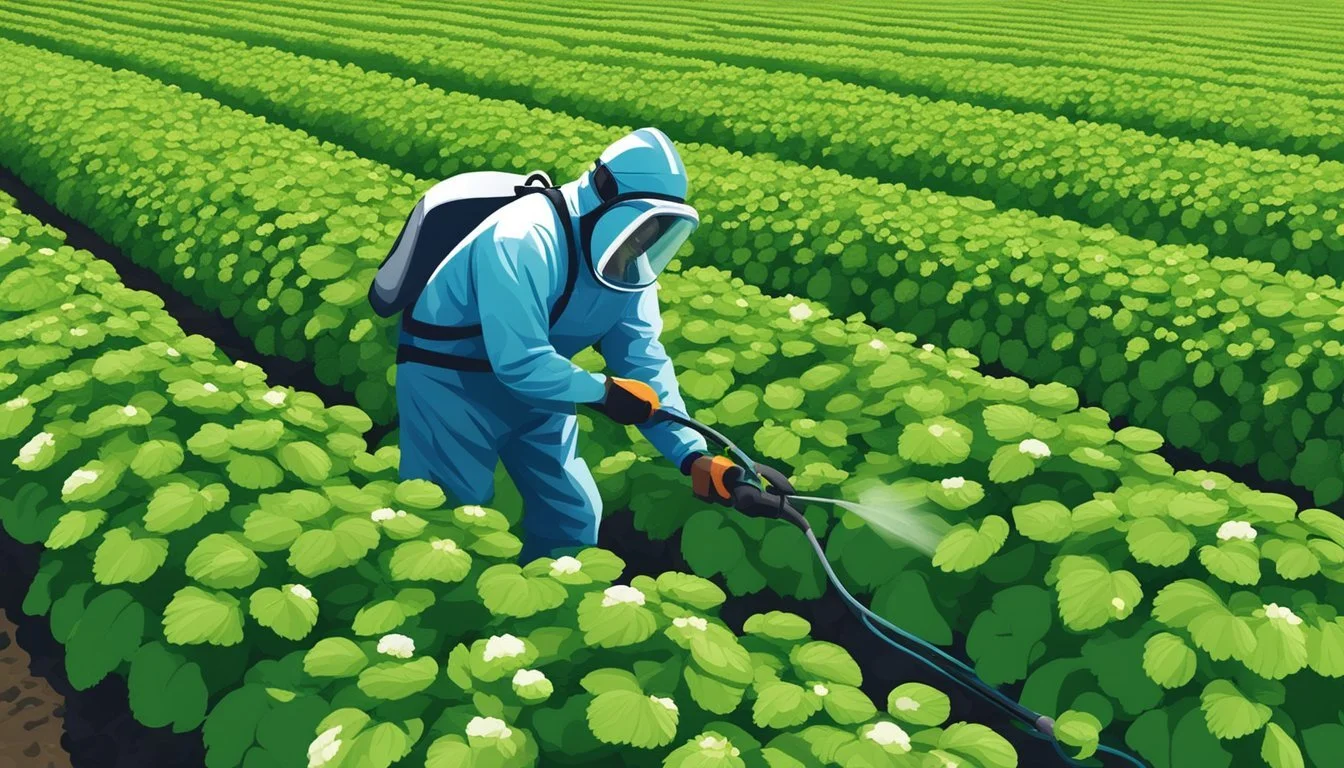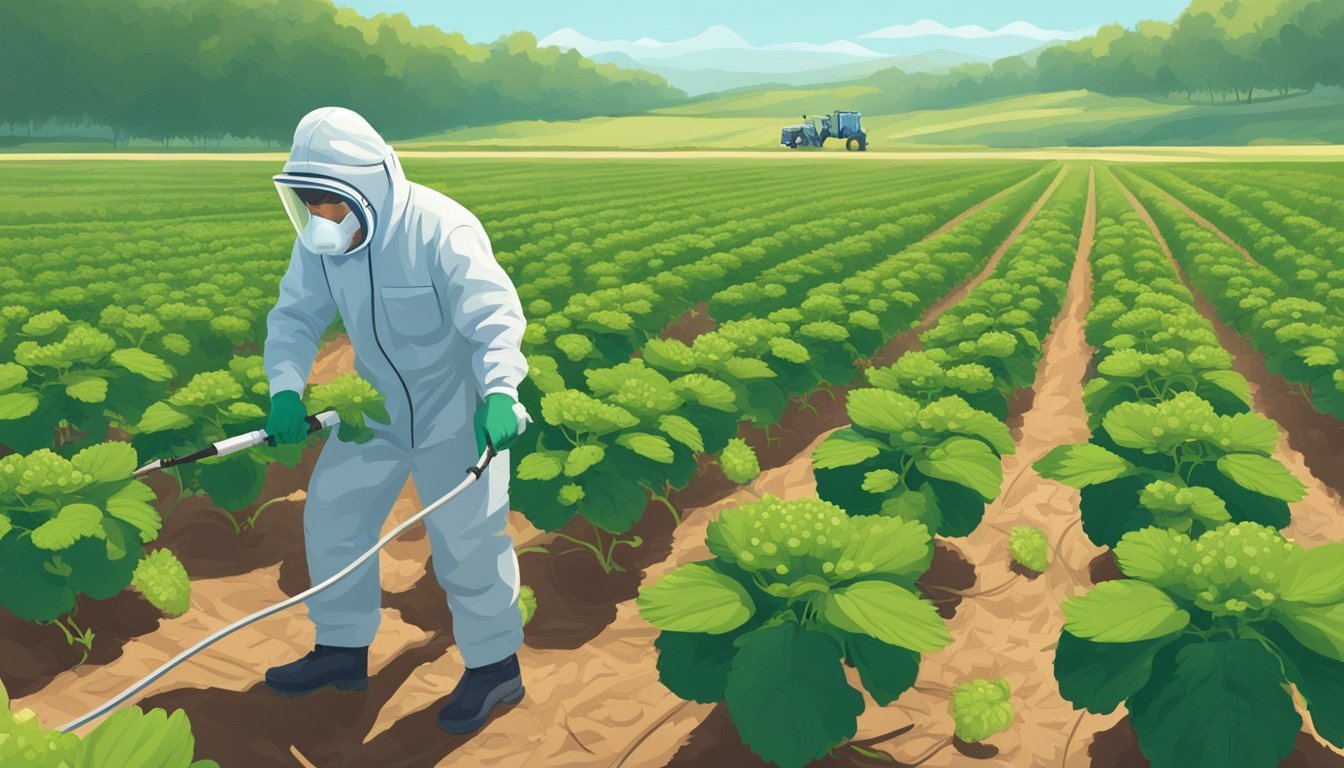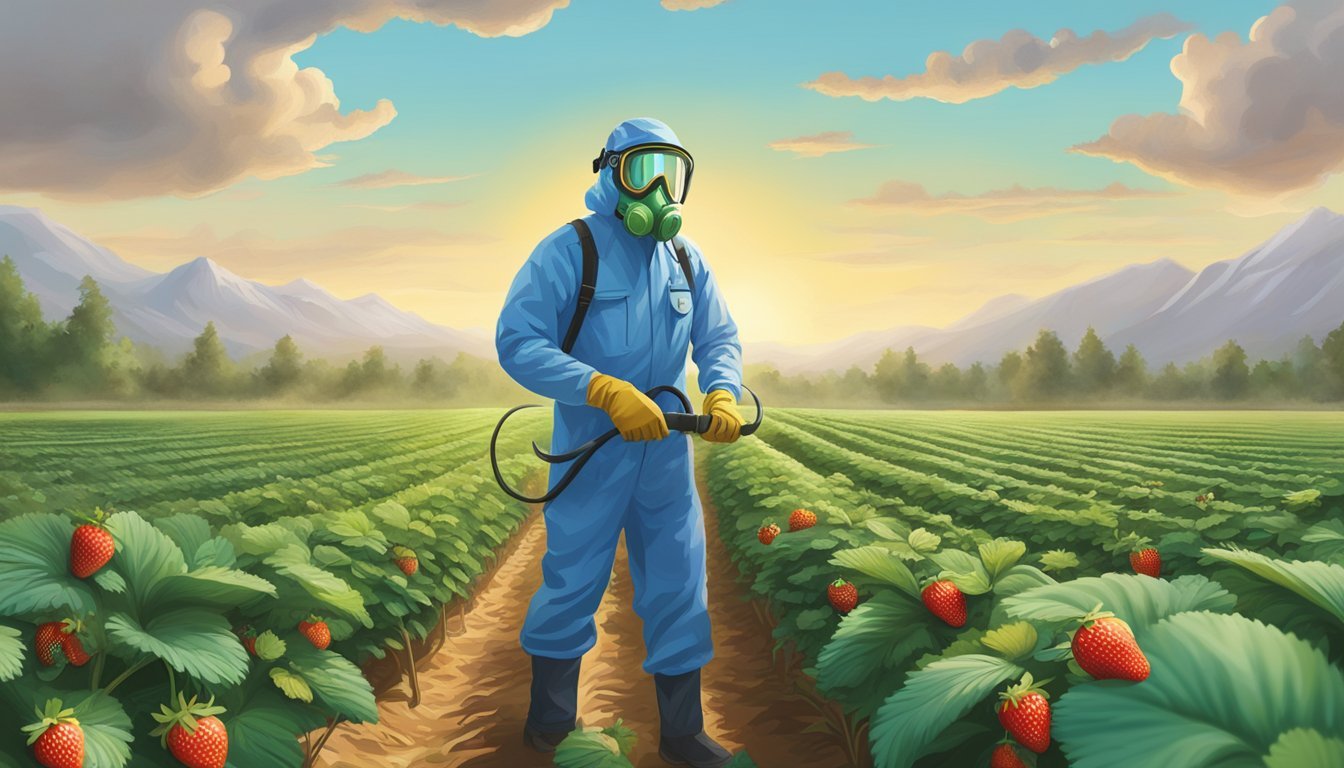Pest Control for Strawberry Fields
Effective Strategies for Healthy Crops
Strawberry production is a rewarding endeavor for both commercial growers and home gardeners, offering the promise of sweet, juicy berries at harvest. However, this process comes with its share of challenges, the most notable being the management of pests which can disrupt growth and yield. Effective pest control is a critical aspect of strawberry cultivation, as it not only ensures the health of the plants but also the quality of the fruit produced.
Common strawberry pests include sap beetles, crown borers, and various other insects that can significantly hinder plant development. These pests may cause direct damage by feeding on the plants or indirectly by introducing diseases. Farmers must employ various methods of control to protect their strawberry fields. From organic approaches such as neem oil or insecticidal soap to innovative techniques like using vacuums to remove pests, the strategies for managing strawberry pests are diverse and can be adapted to different scales of production and levels of infestation.
In seeking to maintain a balance between productive yields and sustainable practices, growers often turn to organic methods of pest control to minimize chemical inputs. Solutions like floating row covers to prevent adult insects from laying eggs, or utilizing natural predators of pests, are just some of the strategies enhancing the overall resilience of strawberry crops against unwanted invaders. By integrating a well-planned pest management system, strawberry producers aim to achieve a successful harvest season after season.
Understanding Strawberry Cultivation
Cultivating strawberries requires meticulous planning and management, particularly in the areas of site selection, soil preparation, plant variety choice, and the establishment and maintenance of the crop.
Site and Soil Preparation
Choosing the right site is critical for the success of strawberry production. One must select fields that have deep, well-drained, sandy loam soils since they offer numerous advantages for strawberries. These soils are easier to prepare, suitable for effective fumigation, and less likely to accumulate salts, ensuring better conditions for plant growth. Prior to planting, it is advisable to manage perennial weeds through methods like crop rotation and soil solarization.
Strawberry Plant Selection
Selecting the appropriate strawberry cultivar is essential. The choice should be informed by the local climate, disease resistance, and market preferences. Plants need to be robust and free from pests and diseases. Understanding the genetic characteristics of the strawberry plants can help with better management of pests and enhance the overall plant growth and strawberry yield.
Planting and Establishment
The planting process is a significant phase in strawberry cultivation. The appropriate time for planting depends on the cultivar and local climate conditions. The spacing is generally 12 to 18 inches within rows with different configurations depending on whether two or four-row beds are utilized. Proper establishment in the field is vital to ensure that plants thrive and mature to their full productive potential.
Irrigation and Fertilization
Strawberry plants require regular irrigation to maintain steady plant growth, especially in periods of low rainfall. Utilizing efficient irrigation systems can help manage water usage and prevent issues related to salinity. Fertilization is also crucial for the development of healthy strawberry plants. The soil should undergo testing to identify the appropriate nutrients needed to match the specific requirements of the strawberry crop.
Pest Identification and Life Cycles
Effective pest management in strawberry fields hinges on identifying pests and understanding their life cycles. This is crucial for determining the most suitable control strategies.
Insect Pests and Mites
Insects and mites pose significant threats to strawberry crops. Aphids are small sap-sucking insects that can transmit viruses and weaken plants. Their populations grow rapidly, leading to large infestations if not managed timely. Tarnished plant bugs feed on developing fruit, causing deformities known as "cat-facing" that render strawberries unmarketable. The life cycle of spider mites, which spin protective silk webbing while they consume plant tissues, can be rapid; these pests may go through several generations during one growing season. Weevils, specifically the strawberry root weevil, lay their eggs at the base of plants; their grubs then feed on roots, causing plants to wilt and die.
Whiteflies: These pests can cause severe damage to strawberries by feeding on plant sap and excreting sticky honeydew, which encourages mold growth.
Grubs and cutworms: Grubs feed on strawberry roots, while cutworms attack the base of plants, cutting off seedlings at the soil line.
Diseases and Fungi
Strawberry plants are susceptible to a variety of diseases and fungi, which often have distinct symptoms. Gray mold is a common issue where berries become covered with a gray, fuzzy fungus, especially in cool, wet conditions. Fruit rot, which often accompanies gray mold, leads to soft, spoiled berries. Verticillium wilt, a soil-borne disease, causes plants to wilt and die back, typically noticed in older leaves first. Powdery mildew presents as a white powdery substance on leaves and can greatly reduce plant vigor if left unchecked.
Anthracnose: This is a fungal disease that results in dark, sunken lesions on fruit and can also affect crowns and leaves.
Leaf spot and black root rot: These diseases affect the foliage and roots respectively, compromising plant health and reducing yield.
Weeds and Invasive Plants
Weeds and invasive plants compete with strawberries for nutrients, water, and sunlight. Yellow nutsedge is particularly nefarious as it is difficult to control and can rapidly overtake a field if not managed properly.
Common Weeds: A variety of common annual and perennial weeds can infest strawberry fields, necessitating vigilant management.
Pest Management Strategies
Effective pest management in strawberry fields requires a multi-faceted approach that addresses the spectrum of potential threats, including insect pests, weeds, and diseases. Key strategies include cultural practices, biological control, chemical applications, and physical or mechanical methods, often all integrated into a holistic management system known as Integrated Pest Management (IPM).
Cultural Practices
Implementing cultural practices is a foundational approach in strawberry pest management. These practices, designed to create less favorable conditions for pests, include:
Crop rotation to prevent the build-up of pests in the soil.
Sanitation to remove diseased plant material and reduce habitat for pests.
Regular pruning to maintain airflow and minimize disease risks.
Biological Control
Biological control involves the use of natural enemies, such as predators and parasites, to suppress pest populations. This method can include:
Introducing or conserving predatory insects that feed on common strawberry pests.
Using parasites that specifically target and control pest populations.
Chemical Control
While non-chemical methods are preferred, chemical control using pesticides may sometimes be necessary when pest pressures exceed economic thresholds. Chemical treatments may include:
Herbicides for effective weed control.
Insecticidal soap and neem oil for less harsh treatment against pests.
Synthetic pesticides for serious infestations, applied judiciously to minimize impacts on the environment.
Physical and Mechanical Control
Physical and mechanical control methods physically remove or create barriers to pests. Examples include:
Cultivation to disturb the life cycle of weeds and insects.
Vacuuming to extract pests from plants.
Use of polyethylene mulch to suppress weeds and reduce pest habitat.
Integrated Pest Management (IPM)
Integrated Pest Management (IPM) combines multiple strategies to manage pests efficiently and sustainably. IPM includes:
Regular monitoring and sampling to make informed decisions based on actual pest pressures.
A survey approach to identify and assess the extent of pest and disease problems accurately.
Incorporating these pest management strategies helps in maintaining a healthy strawberry crop, reducing reliance on pesticides, and promoting environmental sustainability.
Special Considerations for Strawberry Fields
When managing strawberry fields, growers must account for specific environmental factors, adopt different strategies for organic production, and follow best practices for harvesting and preserving the quality of the fruit.
Environment and Weather Impact
Strawberries are a delicate crop, sensitive to a range of environmental conditions. In California, for instance, weather plays a significant role in pest development and fruit production. Frost protection is essential as strawberries are vulnerable to cold temperatures. Drip-irrigated fields should ideally have a uniform slope to prevent waterlogging, a condition that can exacerbate pest issues. Practicing sanitation methods such as the removal of ripe and overripe fruits can reduce pest populations and disease spread.
Pest Control in Organic Production
Organic strawberry production places an emphasis on cultural practices and biological control methods. It requires a deep understanding and implementation of integrated pest management (IPM) techniques. For example, research and development efforts have highlighted the importance of soil health and proper field preparations, which may include bed shaping prior to fumigation or soil solarization for weed control. In managing strawberry pests, growers can enlist the help of beneficial predators or apply organically certified pest control products.
Harvesting and Post-Harvest Management
Careful harvesting and post-harvest handling are critical to maintain the quality and longevity of the strawberries. Decisions on when to harvest, often determined by the degree of fruit ripeness, directly affect the susceptibility to pest and disease damage. Effective post-harvest practices including prompt cooling and proper sanitation measures can enhance fruit quality and shelf-life, ensuring the fruits remain in peak condition during transportation and sales.
Pest Monitoring and Thresholds
Effective pest management in strawberry fields relies on the vigilant monitoring of pest populations and the adoption of integrated pest management (IPM) strategies. There should be a systematic approach to surveillance and sampling, which then informs data-driven decision-making. Establishing clear action thresholds for treatment helps in minimizing unnecessary pesticide use, while accurate reporting and documentation support ongoing research and development of IPM models.
Regular Field Surveillance
They conduct regular field surveillance to detect the presence of pests early on. Strawberry growers frequently scout their fields, searching for signs of pest activity such as damage to plants or the pests themselves. Tools like sweep nets, pheromone traps, and other sampling devices are integral for accurate monitoring. During surveillance, key indicators of pest presence are recorded meticulously to aid in the assessment of pest pressure.
Data-Driven Decision Making
Data-driven decision making is pivotal to the IPM approach as it ensures that interventions are timely and relevant. During monitoring events, they gather quantitative data on pest populations, which they compare against historical records and research-based models. This data is then used to predict pest development stages and to decide on the need for and timing of control measures.
Action Thresholds for Treatment
They define action thresholds to determine when pest levels are high enough to warrant control measures. These thresholds are informed by extensive research and can vary widely, for example, the detection of >1 weevil or >1 clipped bud per 2 ft of row may trigger an intervention. By adhering to these thresholds, they can optimize the use of control efforts, promoting economic and environmental sustainability.
Reporting and Documentation
Accurate reporting and documentation of monitoring and treatment events form the backbone of an effective IPM program for strawberries. Detailed records improve the understanding of pest patterns and efficacy of treatments. This information can be vital for compliance with agricultural regulations, to inform future IPM strategies, and to contribute to the wider body of IPM research.
Advanced Research and Development
Advancements in the field of pest management for strawberries have seen significant growth, leveraging new research and development to foster effective and sustainable practices. This progress is particularly notable in the domain of biological control, where understanding complex ecological interactions is crucial.
Innovations in Pest Control
Biological control has emerged as a keystone in the foundation of innovative pest management strategies. Researchers are focusing on enhancing the effectiveness of natural predators and exploring novel biocontrol agents. Studies like the one detailed in "Arthropod Pest Management in Strawberry" have shed light on the global utilization of integrated pest management techniques, incorporating biological control as a key element in reducing reliance on chemical pesticides.
Development efforts are not only concentrating on perfecting biological control agents but also on the integration of these solutions with other pest management methods. For instance, the UC IPM Publication outlines the use of up-to-date information from experts to manage pests effectively, which aligns with the integrated pest management (IPM) approach that balances the use of biological methods with other control strategies. The emphasis on IPM not only offers environmental benefits but also enhances the sustainability of strawberry production.
Furthermore, the strawberry research community has been proactive in assembling forums like the North American Strawberry Symposium (NASS), referenced in the "New Directions for Strawberry Research in the 2020s", to exchange innovative ideas and findings, especially concerning pest management techniques. These gatherings are pivotal in driving forward both research and practical development aimed at creating robust, science-based pest management solutions. The shared knowledge from such conferences influences strategic decisions in both commercial and academic spheres.
Research has also intensified around the emerging challenges posed by invasive pests, signaling that strategic responses are required to adapt to the evolving pest landscape. The ongoing study and deployment of integrated pest management mentioned in publications such as "Insects | Free Full-Text | Arthropod Pest Management in Strawberry - MDPI" serve as testimonies to the industry's dedication to advancing pest control methodologies.
Through these concerted efforts in research and development, it becomes evident that the strawberry industry is not only addressing current pest challenges but also preempting future issues. Progress in biological control and the integration of varied pest management strategies underpin the thrust towards ecologically sound and economically viable strawberry cultivation.
Regulatory and Safety Considerations
Effective pest management in strawberry production must account for regulatory compliance and a commitment to safety. It's essential that strawberry growers and pest control professionals stay informed about the latest pesticide regulations and conduct thorough environmental impact assessments.
Pesticide Regulations and Safety
Pesticides are subject to stringent regulations to ensure they are used safely. These regulations encompass product registration, usage, handling, and worker safety standards. For strawberry growers, it is imperative to:
Follow the label directions on each pesticide, as these are legal requirements that outline proper application rates and methods.
Ensure that those applying pesticides have proper training and certification.
Utilize personal protective equipment (PPE) in accordance with label and regulatory mandates.
For example, the University of California's Integrated Pest Management Program offers guidelines that include safe pesticide application practices.
Environmental Impact Assessments
Before the application of pesticides, an environmental impact assessment can determine potential risks to the surrounding ecosystem. Strawberry growers should:
Consider non-pesticidal alternatives where appropriate, such as crop rotation and biological control agents.
Evaluate the implications of pesticide use on beneficial insects, soil health, and nearby water sources.
By assessing the broader environmental effects, growers can take steps to minimize negative impacts and focus on sustainable pest control practices. The Southeast Regional Strawberry Integrated Pest Management Guide suggests basing pest management on field presence to reduce preemptive pesticide use.
Conclusion
Effective pest management is crucial for the sustainability and profitability of strawberry production. Employing integrated pest management (IPM) techniques not only reduces the reliance on chemical pesticides but also supports environmental stewardship. It is evident that regular monitoring and the use of biological controls can significantly reduce pest populations.
Farmers should consider the following practices:
Scouting: Regular field inspections both day and night can help identify pests early.
Biological Controls: Utilizing natural predators can keep pest outbreaks in check.
Cultural Techniques: Crop rotation and clean cultivation can disrupt pest life cycles.
The importance of these methods has been documented in diverse studies, including those focusing on the management of arthropod pests in strawberries. Collaboration with extension services is recommended to keep abreast of evolving IPM strategies.
Moreover, advances in the development of safe and effective botanical and microbial pesticides offer promising alternatives. As resistance to conventional pesticides continues to rise, reliance on such ingenuities becomes paramount. Continued research and extension of knowledge are essential to evolving with the dynamic nature of pest threats.
Implementing these practices contributes to a resilient approach to pest management that ensures the quality and yield of strawberry crops for future generations.
Frequently Asked Questions
Effective pest management in strawberry fields is crucial for yield and quality. Tackling common concerns can optimize production and sustainability.
What is the best integrated pest management approach for strawberry fields?
An integrated pest management approach for strawberries combines cultural practices, biological control, and chemical applications to minimize pest damage while considering environmental and human health.
How can I protect my strawberry plants against aphid infestations?
Regular monitoring and the use of natural predators like ladybirds can help protect strawberry plants against aphids. Reflective mulch and aphid-resistant plant varieties are also effective strategies.
Are there organic methods for controlling pests in strawberry fields?
Yes, there are organic methods for controlling pests in strawberry fields, including the use of beneficial insects, crop rotation, and organic-approved pesticides.
What measures can I take to prevent slugs and snails from damaging my strawberries?
To prevent slugs and snails, one can use barriers such as copper tape, remove hiding places like weeds and debris, and encourage natural predators like birds and ground beetles.
Which pesticides are safe and effective for use on strawberry crops?
Safe and effective pesticides for strawberry crops are those that are specifically labeled for use on strawberries and applied according to the label's instructions to minimize risks to non-target organisms.
How can I manage pest infestations in strawberries without harming beneficial insects?
Managing pest infestations while preserving beneficial insects involves using selective pesticides, timing applications carefully, and maintaining habitat for beneficial species.






